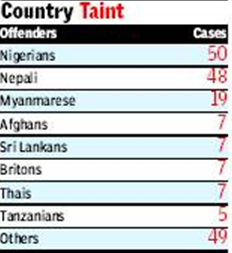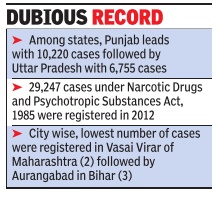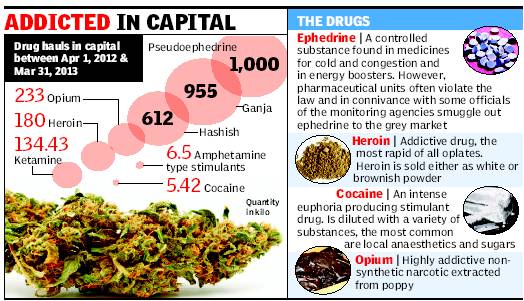Drugs/ Narcotics: India
(→Seizures) |
(→State with highest quantity of seizure and respective drugs/2017) |
||
| (One intermediate revision by one user not shown) | |||
| Line 174: | Line 174: | ||
The officers named in the report are drug controller O S Sadhwani, joint commissioner B R Masal, joint commissioner S T Patil (retired), assistant commissioner S M Sakrikar, assistant commissioner M S Jawanjal Patil, drug inspectors V R Ravi and B D Kadam. | The officers named in the report are drug controller O S Sadhwani, joint commissioner B R Masal, joint commissioner S T Patil (retired), assistant commissioner S M Sakrikar, assistant commissioner M S Jawanjal Patil, drug inspectors V R Ravi and B D Kadam. | ||
== Rajasthan: Drugs worth Rs 10,000 crore seized/ 2016== | == Rajasthan: Drugs worth Rs 10,000 crore seized/ 2016== | ||
| + | |||
[http://epaperbeta.timesofindia.com/Article.aspx?eid=31808&articlexml=Drugs-worth-Rs-10000-crore-seized-from-Raj-02112016009011 Drugs worth Rs 10,000 crore seized from Raj pharma factory, Nov 02 2016 : The Times of India] | [http://epaperbeta.timesofindia.com/Article.aspx?eid=31808&articlexml=Drugs-worth-Rs-10000-crore-seized-from-Raj-02112016009011 Drugs worth Rs 10,000 crore seized from Raj pharma factory, Nov 02 2016 : The Times of India] | ||
| Line 180: | Line 181: | ||
The factory belongs to Ravi Dudhani, nephew of international drug dealer Subash Dudhani who operated from Dubai.The drug manufactured was supplied through a large network of agents. | The factory belongs to Ravi Dudhani, nephew of international drug dealer Subash Dudhani who operated from Dubai.The drug manufactured was supplied through a large network of agents. | ||
| + | |||
| + | ==State with highest quantity of seizure and respective drugs/2017== | ||
| + | See graphic. | ||
| + | |||
| + | [[File: State with highest quantity of seizure and respective drugs, 2017.jpg|State with highest quantity of seizure and respective drugs, 2017; [http://epaperbeta.timesofindia.com/Gallery.aspx?id=14_02_2017_011_043_002&type=P&artUrl=STATOISTICS-DRUG-ABUSE-WHICH-STATE-IS-MOST-AFFLICTED-14022017011043&eid=31808 The Times of India], February 14, 2017|frame|500px]] | ||
=Which drugs are most widely used?= | =Which drugs are most widely used?= | ||
Revision as of 22:17, 23 March 2017

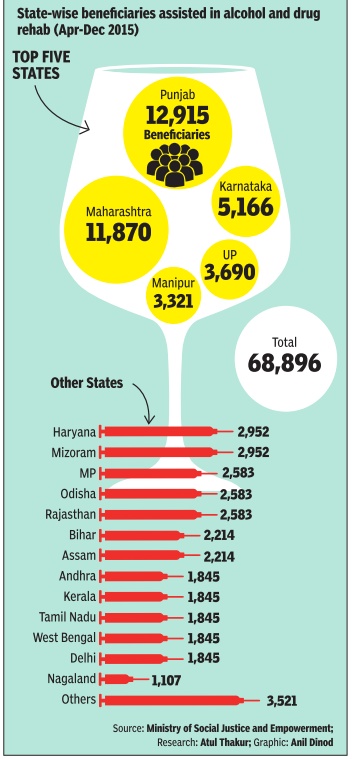

This is a collection of articles archived for the excellence of their content. Readers will be able to edit existing articles and post new articles directly |
Contents |
Central Bureau of Narcotics(CBN)
Jan 22 2015
Before 1950, laws dealing with narcotic drugs came under the Opium Act 1857 & 1878 and the Dangerous Drugs Act 1930. These were merged in 1950 after the formation of the opium department, now known as the Central Bureau of Narcotics (CBN). CBN is responsible for supervision of licit cultivation of opium and for enforcing laws on illegal trade and use of drugs.
Drug trade
Nigerians top list of foreigners held in drug trade/ 2009
Jayaraj Sivan | TNN 09
Chennai: Every third foreign national arrested for drug-related offences in the country last year was from Africa and every fourth from Nigeria alone. Neighbouring Nepal (48 arrests), which didn’t lag far behind either, along with Nigeria, accounted for almost 50% of the total 199 arrests of foreigners effected for drug offences. Mynamarese form the third biggest chunk on the list with 19 arrests. Foreigners are, however, hugely outnumbered by locals in the trade. For every foreigner arrested, 99 Indians were also picked up, according to the 2008 annual report of the Narcotics Control Bureau (NCB) released recently.
African drug syndicates pose a major challenge to drug enforcement agencies in India, primarily because of their trans-national links. Located within reach of the South American cocaine belt, West African nationals, especially Nigerians, play a decisive role in the drug’s trafficking. Often, cartels prey on the African diaspora. ‘‘Many, who come to India as students or businessmen, unwittingly bump into drug smugglers when people of the same nationality meet. Lured by the prospect of quick money, some of them fall into the trap. We’ve come across many first-time offenders among Africans,’’ said south zone director of NCB, S Davidson Devasirvatham.
Apart from Nigerians arrested last year (50), other African nationals who figured on the Indian drug radar are Tanzanians (5), Zambians and South Africans (3 each), Kenyans and citizens of Ivory Coast (two each) and one each from Cameroon, Uganda, Congo and Liberia. Barring Zambia, India doesn’t have a bilateral agreement or memorandum of understanding on sharing information on drugrelated crimes with any of these African nations.
While Africans take heroin out of the country, they bring cocaine back into India to exploit its potential as a recreation drug in metros like Delhi and Mumbai and some tourist destinations, says NCB director general OPS Malik in the report. A total of 50 seizures adding up to 12 kg of cocaine, which has a street price of Rs 3,000 per line of 0.5 gram, was made across Indian cities last year.
The most preferred modusoperandi is to send the contraband through ‘‘post or courier parcels’’ and ‘‘human mules’’, mainly women from South East Asian countries. A large number of locals are also used. This modus operandi gives the advantage of anonymity to the actual kingpins and makes it difficult for investigating agencies to trace the masterminds of the trade. It also ensures that seizures don’t leave a financial dent on the traffickers’ operating costs.
A senior police officer said, ‘‘We have information that several Nigerians who were involved in SMS and e-mail lottery frauds had used the booty for the narcotics trade. This helps them operate virtually without any capital investment.’’
Although the number of arrested foreigners went up from 181 to 199 between 2007 and 2008, there is no perceivable long-term trend as regards their involvement in the overall trade of narcotics in the country. In 2006, 232 foreigners were arrested as the trade saw a sudden spurt in the involvement of foreign nationals in drug trafficking, but the number fell the next year, only to go up again in 2008.
African nationals concentrate primarily on the traditional trafficking route of heroin — from Pakistan to India through western borders.
Cities with the highest drug trafficking: 2012
With 1,512 cases, Mum tops in drug trafficking/ 2012-13
Delhi Second With 829 Cases: NCRB
The Times of India Jun 23 2014
Of the over 50 Indian cities which reported maximum cases of drug trafficking in 2012, the national capital is at the second spot behind Mumbai while Punjab leads among states followed by Uttar Pradesh, indicates National Crime Record Bureau (NCRB) data.
Citing comprehensive data available for 2012, the NCRB said Mumbai registered maximum cases of drug trafficking at 1,512 followed by Delhi with 829 cases therefore leading the group of 53 Indian cities that are highly active when it comes to drug trade.
Data for 2013 is yet to be compiled.
Delhi is followed by Kanpur (Uttar Pradesh) with 551 cases, Amritsar with 457, and Kota (Rajasthan), with 242 cases. Meanwhile, the lowest number of cases were registered in Vasai Virar of Maharashtra (2), followed by Aurangabad in Bihar (3), Dhanbad and Ranchi (4 each) and Vadodara and Rajkot (5 each). A total of 29,247 cases under Narcotic Drugs and Psychotropic Substances Act, 1985, were registered in 2012 compared to previous year’s 29,048 cases.
As per the state wise NCRB data, Punjab has emerged at the top position with 10,220 registered cases in 2012 followed by UP with 6,755 cases, Maharashtra, 1,903 cases, Tamil Nadu, 1,402 cases and Rajasthan with 1,115 cases.
J&K registered 411 cases while Gujarat, despite sharing its border with Pakistan, which is major supplier of narcotics, registered only 68 cases.
The lowest number of cases were reported from Sikkim (3) followed by Andaman and Nicobar Islands (4), Puducherry (6) and Lakshadweep (11).
The data further said a total of 13,459 people, including 216 foreigners, were arrested and 89,519 kg of drugs including opium, morphine, heroin, ganja, hashish, cocaine, methaqualone, ephedrine, LSD, acetic anhydride, and amphetamine were recovered. IANS

Narcotics: Delhi transit hub/ 2013
Delhi transit hub in narcotics corridor
Dwaipayan Ghosh TNN
New Delhi: Data released by Narcotics Control Bureau on International Day Against Drug Abuse has once again shown how Delhi is rapidly emerging as a transit point of high-end drugs smuggled by international cartels.
While the capital lags behind other states in use of ganja and opium, it ranks high in consumption of party drugs such as ketamine and cocaine. Maharashtra is the top consumer of party drugs, according to this data. Between April 1, 2012 and March 31, 2013, a total of 143.43kg ketamine has been seized in Delhi compared to Maharashtra (2,170kg) and Tamil Nadu (596kg). Ketamine is produced illegally in the latter states for supply to southeast Asian countries. The fact that Delhi ranks three on the list when it is not even a major producer indicates it is a transit point. Police said this is due to its unique location between producers Afghanistan and Commonwealth of Independent States nations and consumers in southeast Asia.
According to top officers in the narcotics wing and NCB officials, pseudoephedrine—used to make party drugs like ‘Speed’ and ‘Ecstasy’—is a good example of a transit drug. The total seizure of pseudoephedrine in the past one year in north, east and northeast India have been more than 4,500kg.
The figures also include a cocaine haul of 5,429kg and 180kg heroin. The cocaine circuit is dominated by African cartels who also engage in heroin trade. But most of the heroin seized in the capital are of southwest Asian origin and enters India through Pakistan border, says an NCB study.
Security agencies have long believed that some of the money in this trade is actually a portion of narco-terrorism wherein profits from selling this drug is used to fund terror activities. A total of 612.08kg hashish, 955.58kg ganja and 233.42kg opium were also seized from the capital in this one year. A new item on the list is ATS (amphetamine-type stimulants). Over 6.5kg ATS was seized in the city vis-à-vis Maharashtra (40kg).
“It is believed that, due to establishment of special ATS labs, some foreign operatives are using the country’s huge chemical base to source raw materials and produce such drugs. Drug hauls on Delhi-Manipur route show they are being trafficked to Myanmar,” the NCB noted.
“Recent seizures of Kolkatabound consignments in eastern and northern India indicate that the mafia is using West Bengal's ports to smuggle banned drugs to South America. A group of pharmaceutical companies are handing out stocks from Uttarakhand. This is then brought to Delhi en route to northeast, Myanmar and Thailand. The processing is completed in factories there before the drugs are pushed backed to India. While a portion returns to party circles in Delhi and Mumbai, the rest is shipped out to Colombia and Uruguay where these drugs are in high demand,” said an NCB official.
NCB also asked agencies to crack down on abuse of prescription drugs with the smuggling of codeine-based Phensedyl increasing across borders.
The extent of the problem
Punjab, 2016
Rohan Dua 27% of Punjab cop aspirants found doping used marijuana, Oct 13 2016 : The Times of India
Candidates Also Used Performance Boosters, Morphine, Opium
The compilation of data on candidates who failed the dope test during the Punjab police recruitment process has shown that 1,775 out the 6,558 aspirants who tested positive for drugs had used marijuana.
The recruitment of around 7,416 constables, announced in July , was largely seen as a poll sop ahead of the 2017 elections, and nearly 3,75,862 candidates had appeared for the test.
According to the details accessed by TOI, marijuana was the most commonly used substance by the candidates.
Performance drug amphetamine was detected in 1,672 candidates, while 1,372 had used benzodiazepine, and morphine was found in 1,238. Apart from this, samples of 388 candidates were found to have traces of multiple drugs, including heroin and opium.
Under fire over drug use and trade in Punjab, SAD had introduced this test to help improve its image before the elections. Most of the aspirants who failed the test were from Fazilka and Patiala.While 396 drug abusing candidates were found in Patiala, 386 such candidates were detected in Fazilka.
Women candidates (almost 1.23 lakh) did not have to take the dope test.
According to an AIIMS survey, there are nearly 8.6 lakh opioid users and 2.3 lakh opioid drug dependents in Punjab. The state is already facing a massive political war about political patronage to drug mafia. Enforcement Directorate (ED) is also investigating the Rs 6,000-crore synthetic drug scam.
Seizures
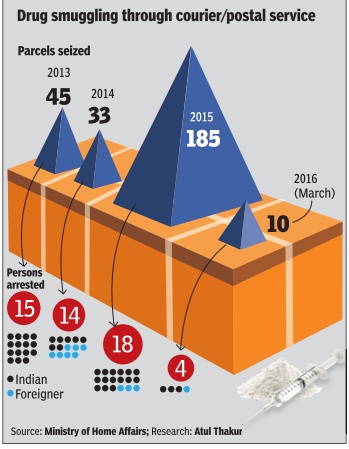
Eight party drug factories busted/ 2015
The Times of India, January 21, 2016

8 party drug factories busted in a yr
The Directorate of Revenue Intelligence has busted eight illicit drug factories across India in the last one year and has unearthed at least 11 other drug cartels that had their networks spread from Vadodara to Delhi and from Dehradun to Kala Amb in Himachal Pradesh. While Delhi, Chennai, Hyderabad and other megacities were always a target for drug cartels which pushed amphetamine-based party drugs like Ice, Ecstasy and Meow Meow, some of the latest busts have been in places like Dehradun and Mt Abu--with a high student population and boarding schools--which has sent alarm bells ringing.
The latest illicit drug factory to be raided was in Delhi's neighbourhood Bhiwadi, just two days before Christmas, manufacturing psychotropic substances (party drugs) ketamine. Over 64 kg of the chemical was seized.
Just an year ago, on February 27, DRI had seized 500 kg of mephedrone in the national capital, and the trail led to unearthing of an illicit drug factory in Sholapur, Maharashtra.Mephedrone is produced by making a change in the chemical composition in other banned psychotropic substances such as ephedrine to escape prosecution.However, after a lot of reported abuse of the substance, the gov ernment brought it under the prohibited category liable for prosecution under the NDPS Act last year. A tablet of Ecstasy or Meow Meow comes cheap compared to the street price of cocaine and is popular in party circles . Many pharmaceutical companies are believed to be behind diversion of the precursor chemicals which are used by car els to manufacture these drugs.
Marijuana: Delhi: Hauls doubled in 2015 from 2014
The Times of India, January 27, 2016
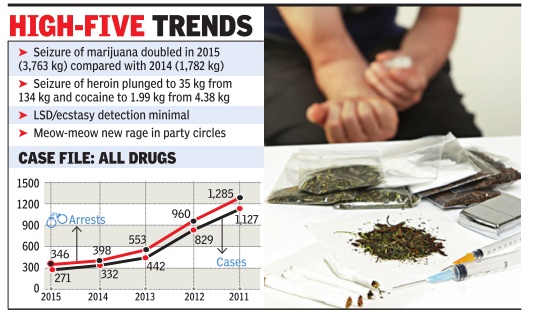
Rajshekhar Jha
The capital is on a high--if police figures on the seizure of banned narcotic substances in 2015 are to be taken as evidence. And while cocaine use might be on the wane, marijuana's popularity among Delhiites is shooting up, making drug cartels eye the capital with interest. The belief of drug enforcement agencies that the demand and supply of marijuana is growing in the capital was corroborated by Delhi Police data showing seizure of marijuana at 3,763 kg last year, double the 1,782 kg bagged by the police in 2014. The busting of a supply module from Odisha in October last year indicated newer traffickers other than the usual ones in Punjab and UP. The Crime Branch had seized 180 kg of ganja, as marijuana is more popularly known, worth Rs 43 lakh and arrested five men for the Odisha racket, in which the opiate was being transported to Delhi nonstop in SUVs driven by a series of men.
Apprehension of charas, or cannabis resin, also shot up from 37 kg in 2014 to around 55 kg in 2015. Charas is prepared manually in areas like Malana, Kasaul and so me other places in Himachal Pradesh.
In 2015, Delhi's party-goers also started experimenting with new drugs, Meow Meow being the most dangerous and addictive among them. The entry of Meow Me ow, limited to Mumbai till 2014, indicates how organized and lucrative Delhi's drug market is becoming. Police data showed most consumers of this chemical compound to be college students and youngsters. Several students of Delhi University were investigated after a Meow Meow ring was busted by the north district police. To evade the cops, the traffickers got customers to identify themselves over the phone using a cat call. The fact that the arrested peddlers were planning to sell the drug at the Scrillex music event in Gurgaon showed the peddlers were keen to branch out into the NCR.
However, apart from these, the Delhi Police registered an all-time low in terms of arrests and recoveries for other narcotics. The police said that their inability to raid the sources, most of them outside India, was the reason for the lukewarm results. Police snagged 35 kg of heroin and cocaine put together in 2015, when it had seized 133 kg of heroin alone a year earlier.And though believed to be rampant in the capital, the recovery of just 1 kg of cocaine in 2015 contrasted hugely from the 4 kg bagged in 2014.
LSD, the most powerful psychotropic drug available globally , was first noticed in the capital in 2013. The highprofile death of NRI Anmol Sarna in Kalkaji had confirmed the presence of the drug in Delhi's party circles. However, the police's success in checking this drug, suspected to originate mostly in Russia, has been minimal.Compared with 34 grams in 2014, only seven grams of LSD were recovered in 2015.
The 2015 trends show growing use of drugs in the capital fed by a more organised network of peddlers. Delhi Police certainly have their task cut out in nipping this in the bud.
Rs 2k cr drug haul leads to bad blood in FDA/ 2016
Sumitra DebRoy, Rs 2k cr drug haul leads to bad blood in FDA, Oct 06 2016 : The Times of India
In probably the first action of this nature, a top Food and Drug Administration (FDA) official has written to the state government and the Narcotics Control Bureau recommending that seven of its own officers, including the drug controller of Maharashtra and three joint commissioners, be charged under the stringent Narcotic Drugs and Psychotropic Substances Act for “negligence“ in the Rs 2,000 crore ephedrine drug haul. The move has created ripples in the organisation, dividing the drug regulatory body like never before.
In April this year, the Thane crime branch busted what they claimed was one of the country's biggest drug rackets. They found that the controlled substance ephedrine and its salts were stolen out of the premises of Avon Life Sciences, Solapur, and sold in the illegal drug market after purification. The FDA 's vigilance department had subse quently carried out three inspections of the factory and found 28 violations under the NDPS as well as the Drug and Cosmetics Act.
Additionally, the vigilance team under joint commissioner (vigilance) Harish Baijal found that the FDA officials--right from the drug inspectors to joint commissioners--were negligent of not carrying out timely inspections of Avon premises, granting fresh licences without thorough record-checking and failing to prosecute the company for breaches over the years.Around 21,500kg of DL ephedrine base was illegally sold to two other smaller companies without permission.
Based on the findings, Baijal recommended that seven officials be charged under Section 59 of the NDPS Act, applicable to an officer who stops performing his roles or withdraws from duties. If charged, the FDA officials could face a jail term of up to one year.
The report said there was a total failure of regulatory mechanism in a serious subject such as narcotics control and blamed it for facilitating the commission of offence by drug dealers.
The report revealed that Avon premises was not inspected even once between 2013 and July 2015 when the Drug and Cosmetics Act mandates at least one annual visit. The report further states that the drug inspectors did not send detailed reports of their visits to their seniors. The seniors, too, allegedly never bothered to check what was going on in a company that was manufacturing seven out of eight licensed products with controlled substances. The officials even ingnored internal reports of the company that spoke of raw material thefts.
The officers named in the report are drug controller O S Sadhwani, joint commissioner B R Masal, joint commissioner S T Patil (retired), assistant commissioner S M Sakrikar, assistant commissioner M S Jawanjal Patil, drug inspectors V R Ravi and B D Kadam.
Rajasthan: Drugs worth Rs 10,000 crore seized/ 2016
Drugs worth Rs 10,000 crore seized from Raj pharma factory, Nov 02 2016 : The Times of India
In one of the biggest drug hauls in Rajasthan, the narcotics department, BSF and the directorate of revenue intelligence have seized about 25 tonnes of illegal ephedrine powder estimated to be worth over Rs10,000 crore from a pharmaceutical factory in Udaipur and its two godowns in Udaipur and Rajsamand on Friday . The operation began with the seizure of the factory and godowns last week, while the assessment and seizure continued on Tuesday .
The factory belongs to Ravi Dudhani, nephew of international drug dealer Subash Dudhani who operated from Dubai.The drug manufactured was supplied through a large network of agents.
State with highest quantity of seizure and respective drugs/2017
See graphic.

Which drugs are most widely used?
2013: poppy husk
The Times of India, Jan 22 2015
In 2013, quantity wise, poppy husk constituted the biggest chunk of seizures. The second largest chunk was derivatives of fentanyl, a powerful synthetic opiate similar to but more potent than morphine, often mixed with heroin or cocaine to amplify their potency.
Punjab, 2015: Opioids worth Rs 7,500 crore consumed annually
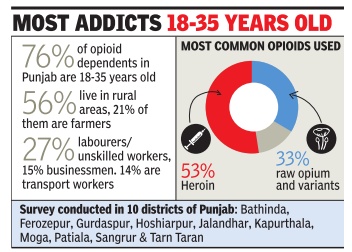
The Times of India, Jan 15 2016
Shimona Kanwar
Punjab sinking in Pak drugs worth Rs 7,500cr|yr: AIIMS
At a time when the nexus between terrorists and drug smugglers in Pakistan has come under the spotlight after the Pathankot airbase attack, a new study by AIIMS has found that opioids worth Rs 7,500 crore are consumed in Punjab annually . Of these, heroin's share is a massive Rs 6,500 crore. This is a startling revelation given that almost all the heroin that comes to Punjab is through the Pakistan border, pumped in by smugglers allegedly aided by ISI. It is this smuggler network that the terrorists who attacked the Pathankot airbase are believed to have used. Security agencies have so far insisted that Pakistani heroin is not consumed in Punjab; it merely passes through to bigger cities like Delhi. But this study -a first of its kind survey by the National Drug Dependence Treatment Centre (NDDTC) at AIIMS -busts the myth.The study covering 10 districts says in a population of around 2.77 crore people, more than 1.23 lakh are dependent on heroin.
Based on the previous studies, Punjab's opioid dependents are four times more than the global average. In effect, not only are the drug smugglers being used to push jihadis into India, they are also creating an army of heroin addicts in Punjab. The study has found that 0.84% (around 2.3 lakh) of the state's population is opioid dependent. It takes into account both opium derivatives as well as artificial substances that have the same effect as opiates on the nervous system.
Previous studies conducted in select districts of Punjab had shown widespread use of synthetic or pharmaceutical opioid drugs. The survey reveals that opioid-dependent people are spending approximately Rs 20 crore daily on these drugs.
On an average, a heroin-dependent individual spends about Rs 1,400 per day . The study -`Punjab opioid dependence survey: Estimation of the size of opioid dependent population in Punjab' -was presented to Punjab health minister Surjit Kumar Jyani on January 6. “I have my doubts about the figure of Rs 20 crore per day . At the same time, the government is seeing this as a warning sign. We will aim for a drug-free state,“ he said.
While around 2.3 lakh people are opioid dependent in Punjab, around 8.6 lakhs are estimated to be opioid users.Heroin-dependents are the highest at 1,23,414. For the survey , the NDDTC collaborated with Delhi-based non-profit organisation Society for Promotion of Youth and Masses.
The study was conducted between February and April 2015. Data was collected from 3,620 opioid-dependents from 10 districts. Among the men aged between 18 and 35, four in 100 are opioid dependent, while 15 in 100 could be opioid users.
“We must also note that this survey estimates a much higher number of injecting drug users in Punjab (around 75,000) as compared to the existing estimate (under 20,000). Thus there is a clear threat of explosive epidemic of HIV among injecting drug users in Punjab,“ said the lead investigator and the principal author of the survey , Dr Atul Ambekar.
In this survey , interviews were conducted mostly at the drug-dependence treatment and rehabilitation centres at the government civil hospitals of Punjab. Each respondent interviewed was asked to send three more people they knew and who were also opioid dependent. The respondents thus came voluntarily to participate in the survey and were interviewed in government hospitals.
2016, Delhi: Synthetic drugs rule parties
The Times of India, Jun 27 2016
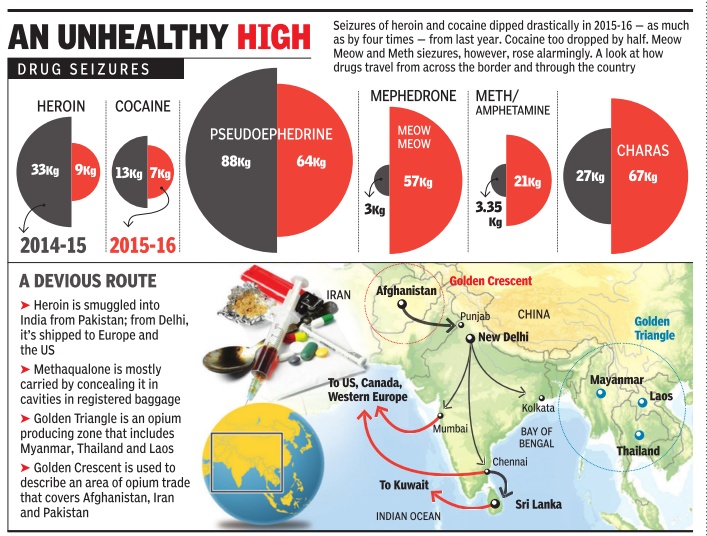
Rajshekhar Jha
Synthetic drugs rule party circles
Heroin and cocaine seem passé for the capital's drug market as people are getting high on synthetic drugs. Methamphetamine aka crystal meth and Meow Meow ruled party circles in 2015-16, reveals data released by the Delhi division of Narcotics Control Bureau on International Day against Drug Abuse. The data shows that consumption and seizures of heroin and cocaine dipped drastically by as much as four times this year--from 33kg in 2014-15, seizures came down to 9kg in 2015-16. Cocaine too dropped by half, from 13kg to 7kg. However, seizures of Meow Meow increased from 3kg to 57kg and meth rose to 21kg from 3kg.
The figures were released by NCB director general RR Bhatnagar and zonal director (Delhi) Rohit Sharma on Sunday. “In 2014-15, we conducted 36 operations and arrested 46 people, including 25 Indians and 21 foreigners. In 2015-2016, we conducted 47 operations and arrested 27 people,“ Sharma said.
The central drug enforcement agency has also identified how drugs travel from across the border and through the country . Heroin is mainly smuggled from Pakistan through six ways. “The floating method involves the sea route. Conceal and clear method involves using PVC pipes and throwing the consignment across the fence on the border. We have also found drugs concealed in white ce ment sacks and moved across the border in trucks,“ Sharma added.
Once it reaches Delhi, heroin is shipped to European and American countries concealed in small parcels by air.The drug is concealed by creating false cavities in books, paintings, machinery parts, combs, designer clothing, shoe soles, decoration items, skipping ropes, artefacts, soft toys, baby clothes, saree falls, ghagras, etc, the NCB said.
Cocaine is concealed in the personal baggage of people travelling to Latin American countries, especially Brazil, by creating false cavities or concealing in food products like milk powder.
Professional “swallo wers“ also traffic cocaine by stuffing the drug in small capsules sheathed in cellophane, rubber or gelatin. The swallowed capsules are retrieved after passing out stool in the destination country .Besides this, cocaine also reaches India from Brazil concealed in courier parcels. “Methaqualone is mostly carried by concealing it in the false cavities of baggage.It is also shipped through parcels. Charas is carried by carriers travelling to Delhi through road or rail. Apart from local consumption, charas is also shipped abroad in parcels concealed in musical instruments, books, wooden decoration pieces, rings of curtains, etc,“ Sharma said.
